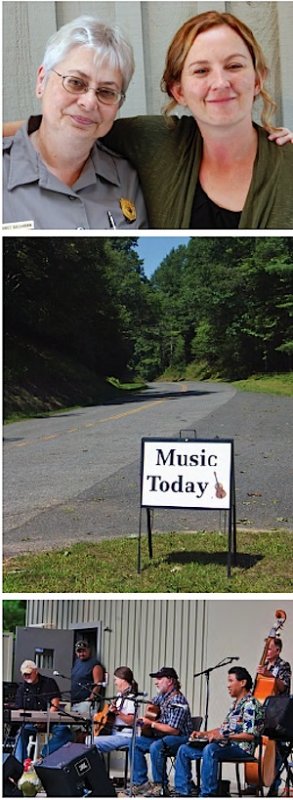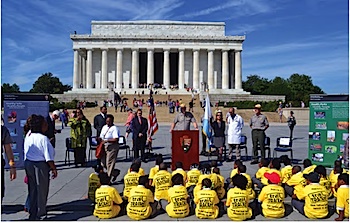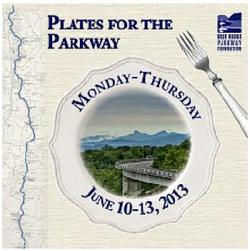When Blue Ridge Parkway Superintendent Phil Francis retired this year, he left after losing “25 percent of our staff in ten years” and sequestration chopping another 5 percent off his 2013 budget.
Superintendent Francis said the National Park Service budget crisis would “require the federal government to rethink funding our parks—friends groups and foundations will need a new vision for a new role in the near future...”
The superintendent might have left, but the Blue Ridge Parkway Foundation is still backing the Parkway and, in fact, inventing that new and innovative role he talked about.
In 2012, the Foundation’s funding for park projects totaled $650,000 and included such innovations as a state-of-the-art Blue Ridge Parkway Communications Center that links national park offices with local law enforcement and emergency services along the 500-mile route long prone to radio dead zones. Other projects include historic restoration and fully accessible trail improvements.
The Foundation’s giving for 2013 is up to $750,000—with a variety of innovative programs that flesh out Superintendent Francis’ prognosis for the future.
Blue Ridge Music Center
“The Blue Ridge Music Center is one of the most musical places on Earth,” says the Foundation’s Erynn Marshall. “It’s nothing less than an epicenter of traditional music.”
This year, at the request of the former superintendent, the Foundation jumps in to support one of the Parkway’s most authentic cultural attractions. This landmark Music Center at Milepost 213 straddles the North Carolina-Virginia state line. It also lies at the crossroads of two heritage music trails in a region known as the birthplace of America’s traditional music.
Spend any time here and you’ll quickly appreciate the Foundation’s commitment to keeping the center’s impressive musical programming both stellar and sustainable.

Blue Ridge Music Center interpretive ranger Janet Bachmann and Erynn Marshall (L to R), the Center’s program manager, lean on each other to make the Center a moving musical experience. The roadside sign that announces mid-day musical concerts. Traditional musicians entertain at the Center’s amphitheater. Top and bottom photos courtesy of Blue Ridge Parkway Foundation, middle photo by Randy Johnson.
On the stellar side, Roseanne Cash and John Leventhaller are among big names in this summer’s world-class concert series, a series held in a beautiful, high-tech outdoor amphitheater prone to perfect sunsets.
Every day, free sessions of Mid-day Mountain Music find local musicians serenading visitors in rocking chairs overlooking Chestnut Creek (Memorial Day to October, 27th, from 12-4 p.m.).
“They’re all volunteers,” Ms. Marshall says, “and many are renowned musicians.” That includes regular performer Bobby Patterson, a Virginia Heritage Award winner and owner of Heritage Records, who sings, plays guitar and banjo.
That’s just the start. Ms. Marshall orchestrates a complete schedule of music, dance, and special events featuring a wide variety of music styles and specialties from gospel to TradFest!, a celebration of young mountain musicians on May 25th.
This entire facility is about engagement, starting with the Roots of American Music Museum where visitors hear the music, watch rare videos, and discover how the sound evolved through the merging of musical cultures.
“People from the region often leave the museum a little teary-eyed,” Ms. Marshall says. “They tell me the center really offers insight into their own history.”
Parkway Weather Initiative
For visitors and Parkway staff alike, “what’s the weather like up there” is the quintessential FAQ on this famously lofty, climatologically complex arm of New England in the South.
To address that, the Foundation is partnering with a North Carolina weather website called Ray’s Weather to bring the Parkway’s sunshine and storms as close as your computer.
Ray Russell, a computer science professor at Appalachian State University and chief prognosticator at the Boone-based weather site, proposed the idea. The website launched this spring, www.brpweather.com, with 18 weather stations and webcams along the Parkway from Montebello, Virginia, to Balsam Gap, North Carolina. The service provides current conditions and custom forecasts all along the route.
“The National Park Service is really excited about being able to sit at a desk and see what’s happening on the most isolated parts of the road,” says Liz Redding, the Foundation’s director of communications. “It’ll help visitors, too. Folks down in Asheville often get perturbed when they can’t get to Mount Mitchell because the Parkway is closed. At least now they can watch the blizzard on the website and say, ‘Wow, no wonder the road’s closed!’”
There’s more than convenience at play here. The Foundation funded the startup cost of cameras, equipment, and installation, and after advertising on the site recoups the private partner’s costs the Foundation will receive an ongoing part of the profits.
Kids In Parks: Massive Track Trails Expansion
A year ago, the Foundation’s innovative Kids in Parks program of self-guided TRACK Trails was singled out for a White House “Champions of Change” award. Where do you go from there? Well, you aim to double the number of trails in a single year, says Jason Urroz, who directs the program.

Children help dedicate a TRACK Trail on the National Mall in Washington, D.C. Blue Ridge Parkway Foundation photo.
Forty-one trails are in place now in North Carolina, Virginia, South Dakota, and Washington, D.C., with an additional 40 trails planned this year. That’s almost one new trail a week in 2013.
The Foundation goes about this project by finding mostly existing trails where it installs signing tied to fun, self-guiding brochures that entice families into the woods. There’s a website where kids can track their hikes, win prizes, and find other trails to try. The program is attracting grants and support because the web data literally verifies the excitement and activity being generated by the trails.
“The program really inspires travel,” Mr. Urroz says. The trails are aimed at city, state, national, and other parks so “after you’ve hiked a city trail, parents can say, ‘hey, there’s another trail in a state park nearby, let’s try that.’ Then they say, ‘Let’s try the national park next.’”
TRACK Trails are what anyone would call an elegant idea. “Our prizes make the trails attractive to kids. They’re self-guided, so no ranger needed. And we collect data to assess success,” Mr. Urroz says. “It’s such a simple concept—but when you package it the way we do, it’s attractive for park users and managers.”
Trails for bicyclists, canoeists, kayakers, Nordic skiers and snowshoers are next.
Shifting Strategies
The Foundation is also refining its fundraising strategies.
Its Parkway Plus Program, subheaded “Eat, Sleep, Donate,” permits guests at participating hotels and restaurants to add a dollar donation to their bill, but “that was really hard for some restaurants, such as chains,” Ms. Redding says.

The Plates for the Parkway event, June 10-13, 2013, permits Parkway supporters to dine at a variety of restaurants up and down the road and have part of their tab support the Foundation.
So Plates for the Parkway is a four-day event, June 10-13, 2013, where restaurants up and down the road can donate a discreet percentage of their guests’ tab.
Another insight surfaced with the Foundation’s effort to fund individual projects, such as resurfacing the boardwalks on the Rough Ridge Trail at Grandfather Mountain.
“We used to donate the money and then invite donations on the website and with on-site signs,” says Ms. Redding, “but we’re changing that to make better use of our supporters’ money—and because we have so many great projects.”
Now the Foundation will “directly fund the ‘invisible projects,’ the ones that aren’t’ sexy,” she says. “And for projects that we think people would get excited about, we’ll ask for donations first. We’ve realized that the incentive to donate is less compelling if the project’s already done.”
The Blue Ridge Parkway Foundation is as long on creativity and innovation as its park is long on road. These folks really seem to have it wired—as you’ll see if you call the group’s toll-free number. No, there aren’t 500 extensions for Foundation employees—they’ve each just chosen their favorite Parkway Milepost as their phone number.
Whether that’s their favorite Parkway site, the exit they take to get home, or in one case, where a staffer grew up, it’s obvious that Foundation employees carry “America’s Favorite Journey” particularly close to their hearts.
Coming Wednesday: The Boone Area High Country


 Support Essential Coverage of Essential Places
Support Essential Coverage of Essential Places






